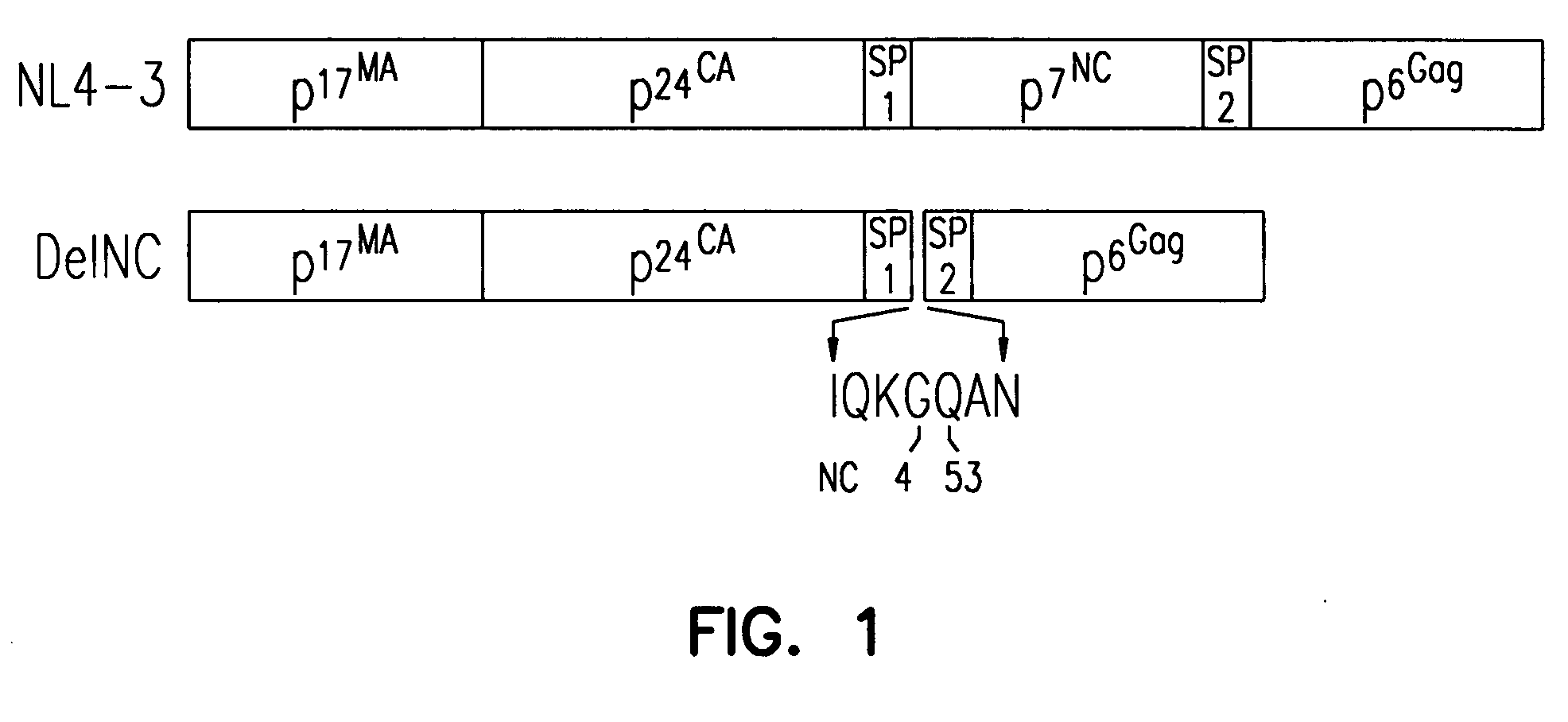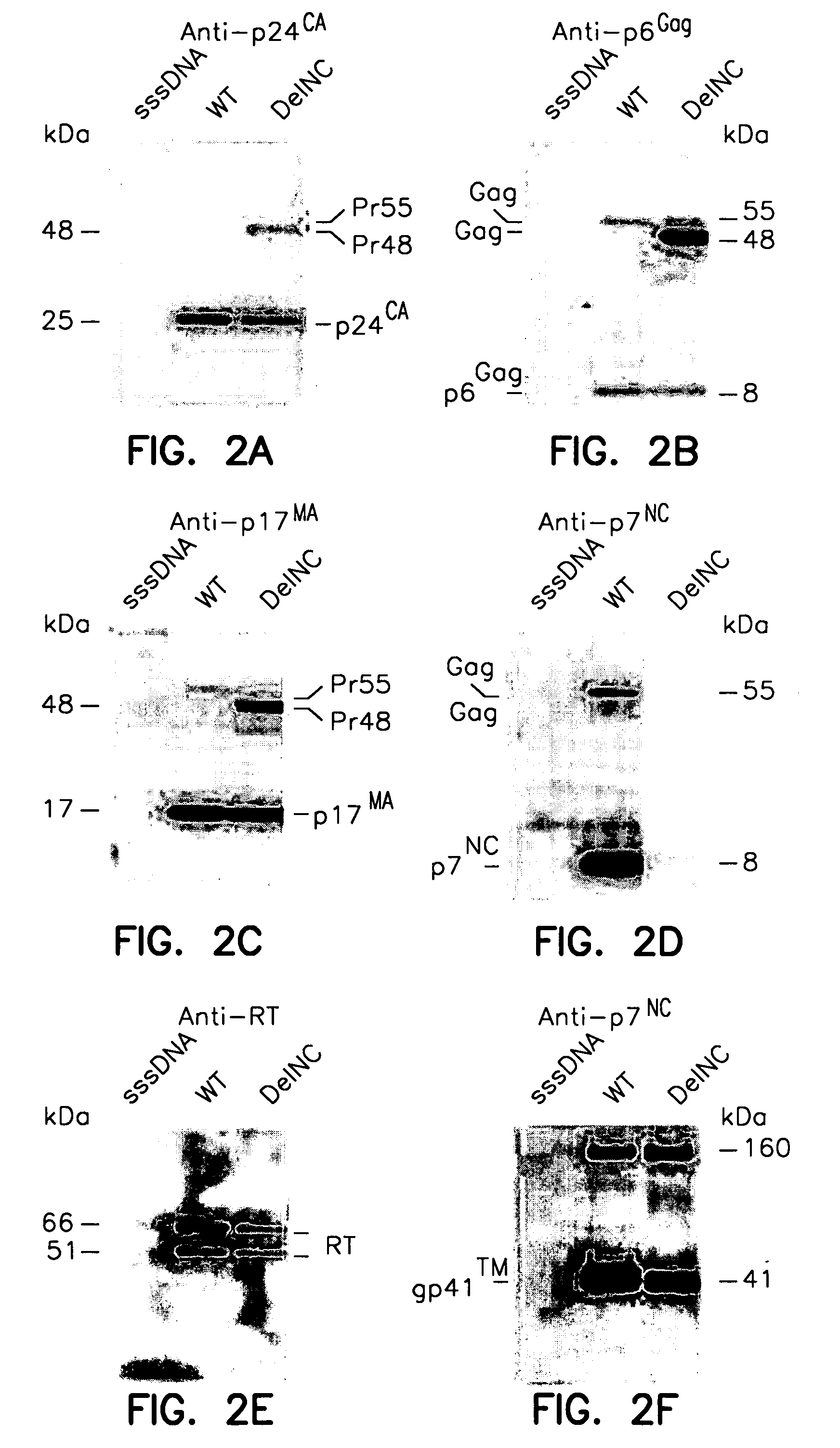Retrovirus-like particles and retroviral vaccines
a technology of retrovirus and similar particles, applied in the field of immunology, can solve the problems of unefficient packaging of retrovirus-like particles, and achieve the effects of reducing enzymatic activity, reducing enzymatic activity, and reducing enzymatic activity
- Summary
- Abstract
- Description
- Claims
- Application Information
AI Technical Summary
Benefits of technology
Problems solved by technology
Method used
Image
Examples
example 1
Creation of a Nucleocapsid Deletion Mutant
[0077] The pNL4-3 infectious molecular clone of HIV-1 (Adachi et al., J. Virol., 61:209 (1987)) (Genbank accession #AF324493) was altered by site-directed mutagenesis using the polymerase chain reaction (PCR)-based overlap extension procedure (Horton et al., BioTechniques, 8:528 (1990)). Briefly, SpeI-BclI or ApaI-BclI fragments containing the desired mutations were generated by the PCR procedure and cloned into pNL4-3 as previously described (Ott et al., J. Virol., 73:19 (1999)). The deletion of NC by this method fused nucleotide (nt) 1932 (the third position C of the glycine 4 codon in NC) to nt 2077 (the first position C of the glutamine 53 codon in NC).
[0078] The importance of NC in HIV-1 Pr55Gag was tested by removing all of the NC residues in Gag except for the first four amino acids and last three amino acids from the pNL4-3 full-length molecular clone to produce the DelNC construct (FIG. 1). The pol frameshift site and pol coding s...
example 2
Cell Culture Methods
[0079] The 293T transformed human kidney and HeLa-CD4-LTR-lacz (HCLZ) (gift of David Waters, AIDS Vaccine Program) cell lines were cultured in Dulbecco's modified Eagles medium; the H9 T cell leukemia line was cultured in RPMI 1640 medium. All media were supplemented with 10% vol / vol fetal bovine serum, 2 mM L-glutamine, 100 units per ml penicillin, and 100 μg per ml streptomycin. All cell culture products were obtained from Invitrogen (Carlsbad, Calif.). Transient transfections of 293T cells were carried out using the calcium phosphate method (Graham et al., Virology, 52:456 (1973)) or with 293T TransIT reagent (Mirus Corporation, Madison, Wis.) according to the manufacturer's recommendation. Virion or retroviral-particle production was measured by reverse transcriptase assay (3H-TMP incorporation using an exogenous template) on cell culture supernatants as previously described (Gorelick et al., J. Virol., 64:3207 (1990)) and CA levels were measured by an HIV-1...
example 3
Analysis of Nucleocapsid Deletion (DelNC) Retrovirus-Like Particles
[0081] Retrovirus-like particles and virions were isolated by centrifugation through a 20% sucrose pad in a SW28.1Ti rotor (Beckman-Coulter, Inc., Fullerton, Calif.) at 120,000 g at 4° C. for 1 hour. Immunoblot analyses of retrovirus-like particles and virion preparations (the equivalent of 10% of the transfection supernatant) were performed as previously described, using peroxidase-conjugated secondary antibodies and developed with the Enhanced ChemiLuminescence reagent (Amersham Life Science, Arlington Heights, Ill.). Rabbit antiserum against p6Gag (DJ-30552) and goat antiserum against, p7NC (#77), p17MA (#83), or p24CA (#81) were obtained from the AIDS Vaccine Program. Monoclonal antibody against reverse transcriptase was obtained from Perkin Elmer / NEN Life Science. N-terminal protein sequence analysis was carried out on an Applied Biosystems Procise model 494 microsequencer (Foster City, Calif.) as previously de...
PUM
| Property | Measurement | Unit |
|---|---|---|
| diameter | aaaaa | aaaaa |
| molecular weight | aaaaa | aaaaa |
| molecular weight | aaaaa | aaaaa |
Abstract
Description
Claims
Application Information
 Login to View More
Login to View More - R&D Engineer
- R&D Manager
- IP Professional
- Industry Leading Data Capabilities
- Powerful AI technology
- Patent DNA Extraction
Browse by: Latest US Patents, China's latest patents, Technical Efficacy Thesaurus, Application Domain, Technology Topic, Popular Technical Reports.
© 2024 PatSnap. All rights reserved.Legal|Privacy policy|Modern Slavery Act Transparency Statement|Sitemap|About US| Contact US: help@patsnap.com










